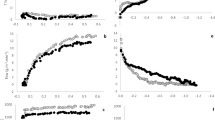Summary
-
1.
Pigeons were acclimatized to heat and to cold by keeping them for several months at 29 and at 10° C ambient temperature under a constant 12 to 12 hours photoperiod. The influence of acclimatization on temperature regulation was investigated by measuring the body weight, the patterns of core and skin temperatures, the heat production and the onset of shivering and panting under different ambient temperatures ranging +35 and −20° C.
-
2.
Acclimatization to either warm or cold environment had no influence on the level of normal body temperature. The lower limit of the indifferent zone (21° C) was unchanged. The increase of heat production with falling ambient temperature in the cold zone (+20° C to −20° C) was the same in both groups (Fig. 2).
-
3.
Cold acclimatized animals had a higher body weight (Fig. 1) due to increase deposit fat. The upper limit of the thermo-indifferent zone, I.e. the threshold of thermal panting, was significantly lower than in warm acclimatized pigeons. Resting metabolic rate as related to metabolic active tissue was elevated by 12%. The skin temperatures of the trunk and of the extremities were higher under all external conditions, probably due to an increased peripheral blood flow.
-
4.
No correlation was found in both groups between the onset and the degree of heat producing and heat dissipating thermoregulatory reactions and the level of mean skin temperature (Figs. 4, 6, 7). Therefore, temperature regulation cannot be based only on peripheral thermoreception, and central thermodetectors must be involved. This assumption is confirmed by the finding that the onset of shivering and of panting and the increase of oxygen consumption in cold occurred at a distinct level of mean body temperature (70% core and 30% mean skin temperature). This mean body temperature threshold of shivering and of panting was the same in heat and cold acclimatized animals (Figs. 4 and 6).
Zusammenfassung
-
1.
An wärme- und kälteakklimatisierten Haustauben (29 bzw. 10° C) wurde die Wirkung äußerer Temperaturveränderungen im Bereich von +35 bis −20°C auf den Verlauf der Kern- und Hauttemperaturen, auf die Höhe der Wärmebildung und auf die Auslösung von Kältezittern und Wärmehecheln untersucht.
-
2.
Die Akklimatisationsbedingungen waren ohne erkennbaren Einfluß auf Höhe und Verlauf der Kerntemperatur, die untere Grenze der thermoindifferenten Zone und die Zunahme der Wärmeproduktion in der Kälte.
-
3.
Die Kälteanpassung hatte eine Zunahme des Körpergewichtes zur Folge, die vor allem auf der Ablagerung von Depotfett beruhte. Die obere Grenze der thermoindifferenten Zone und die Temperaturschwelle des Wärmehechelns lagen deutlich niedriger als bei wärmeakklimatisierten Tieren. Der Ruheumsatz pro Tier war um 12% höher als während der Wärmeakklimatisation. Die Hauttemperaturen unter dem Gefieder und besonders an den unbedeckten Füßen lagen bei gleicher Versuchstemperatur nach der Kälteanpassung höher. Als Ursache wird eine vermehrte Vaskularisation der Haut vermutet.
-
4.
In beiden Gruppen bestand zwischen der Höhe der mittleren Hauttemperatur und der Auslösung sowie der Stärke der thermoregulatorischen Reaktionen keine hinreichend enge Korrelation. Zur Regulation der Körpertemperatur kann daher die Information der peripheren Temperaturänderungen über die Reizung cutaner Thermorezeptoren allein nicht ausreichen. Eine zusätzliche Perzeption der inneren Körpertemperatur durch zentrale temperaturempfindliche Strukturen ist erforderlich. Diese Annahme wird durch den Nachweis gestützt, daß der Beginn des Zitterns und Hechelns und der Anstieg des Sauerstoffverbrauches in der Kälte eng mit der mittleren Körpertemperatur (70% Kern- und 30% Hauttemperatur) korrelierten.
Similar content being viewed by others
Literatur
Dontcheff, L., et C. Kayser: Le rythme saisonnier du métabolisme de base chez pigeon en fonction de la température moyenne du milieu. Ann. Physiol. Physicochim. biol. 10, 285–300 (1934).
Ederstrom, H. E., and S. J. Brumleve: Temperature gradients in the legs of cold-acclimatized pheasants. Amer. J. Physiol. 207, 457–459 (1964).
Gelineo, S.: Sur la thermorégulation chimique optimum du pigeon domestique. C. R. Soc. Biol. (Paris) 147, 134–136 (1953).
—: Température d'adaption et production de chaleur chez les oiseaux de petites tailles. Arch. Sci. physiol. 9, 225–243 (1955).
—: Organ systems in adaptation: the temperature regulating system. In: Handbook of physiology, Adaptation to the environment, sec. 4, p. 259–282. Washington: Waverly Press 1964.
Hart, J. S.: Climatic and temperature induced changes in the energetics of homeotherms. Rev. canad. Biol. 16, 133–174 (1957).
—: Geography and season: mammals and birds. In: Handbook of physiology. Adaptation to the environment, sec. 4, p. 295–321. Washington: Waverly Press 1964.
Héroux, O.: Comparison between seasonal and thermal acclimation in white rats. II. Surface temperature, vascularization, and in vitro respiration of the skin. Canad. J. Biochem. 37, 1247–1253 (1959).
—, and D. Weight: Histological evidence for cellular adaptation to non-freezing cold injury. Canad. J. Biochem. 37, 811–819 (1959).
Irving, L., and J. Krog: Temperature of skin in the arctic as a regulator of heat. J. appl. Physiol. 7, 355–364 (1955).
King, J. R., and D. S. Farner: Energy metabolism, thermoregulation and body temperature. In: Biology and comparative physiology of birds (ed. A. J. Marshall), vol. II, p. 215–288. New York: Acad. Press 1961.
Saalfeld, E. v..: Untersuchungen über das Hecheln der Tauben. I. Mitteilung. Z. vergl. Physiol. 23, 727–743 (1936).
Steen, J.: Food intake and oxygen consumption in pigeons at low temperatures. Acta physiol. scand. 39, 22–26 (1957).
— and I. B. Steen: The importance of the legs in the thermoregulation of birds. Acta physiol. scand. 63, 285–291 (1965).
Sturkie, P. D.: Avian physiology. New York: Ithaca 1954.
Author information
Authors and Affiliations
Additional information
Für die freundliche Beratung bei der Auswahl der für das Versuchsmaterial geeigneten statistischen Methoden möchte ich Herrn Dr. O. Ludwig, Statistische Abteilung des Kerckhoff-Institutes, Bad Nauheim, meinen Dank aussprechen. Ferner bin ich Fräulein B. May für ihre Assistenz bei den Versuchen zu Dank verpflichtet.
Rights and permissions
About this article
Cite this article
Rautenberg, W. Untersuchungen zur Temperaturregulation wärme- und kälteakklimatisierter Tauben. Z. Vergl. Physiol. 62, 221–234 (1969). https://doi.org/10.1007/BF00302286
Received:
Issue Date:
DOI: https://doi.org/10.1007/BF00302286




